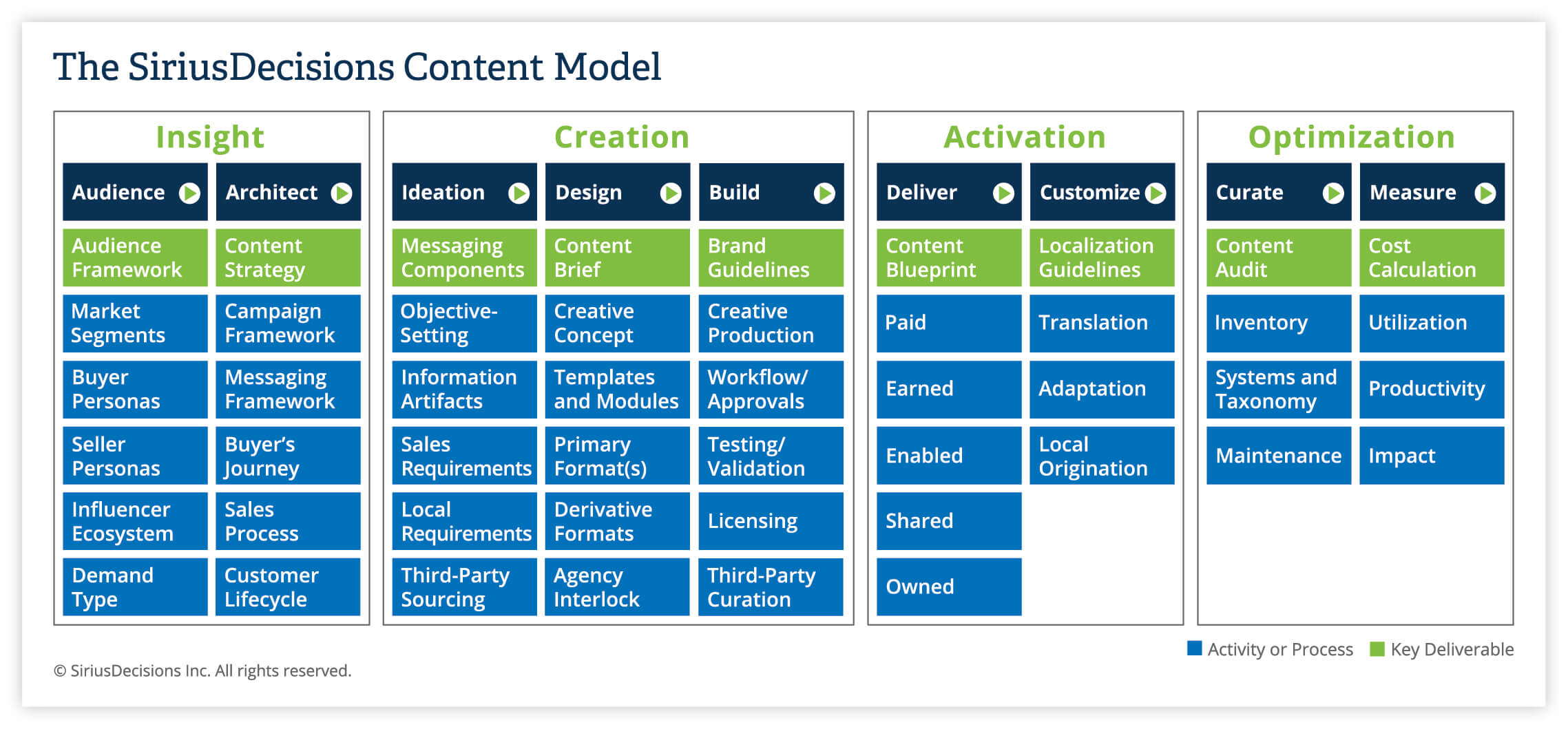Healthcare Spotlight: Top 10 Priorities for Accelerating Sales With Improved Content
- B2B healthcare organizations waste significant funds on content creation and management, letting up to 70 percent of content go unused
- Many healthcare organizations have no idea how much is spent on content creation and management, how many sources exist or which content is used
- Successful marketing leaders are creating and deploying content centers of excellence to improve content effectiveness, lower costs, drive operational efficiencies and enable sales
Editor’s note: This is the fourth in a series of blog posts that describe how B2B healthcare leaders are driving results with innovative marketing, sales and product strategies. Although the approach of each blog post may vary, the concept is consistent: examining what’s really working for B2B and B2B2C healthcare leaders today, on the basis of SiriusDecisions clients’ priorities and progress.

An innovative CIO once told me, “Information is not power. Access to it is.” A major area of opportunity for B2B healthcare marketing leaders is how they organize and manage information in the form of content assets that must be relevant to sales reps and buyers and accessible at the point of need. I have seen many organizations struggle with issues such as too much content that is irrelevant to sales and customers, off-brand content, noncompliance, and sales reps’ inability to find what they need. According to data from the SiriusDecisions Command Center®, up to 70 percent of B2B content is unused, and 62 percent of organizations report that sales reps must look in six or more places to find content when they need it.
A content center of excellence (COE) can help solve some of these problems. To determine if you need a content COE, answer the following questions about the content you develop and manage:
- How much do you spend on developing and managing your content assets?
- Is your content organized around the phases of the buyer’s journey, customer lifecycle and sales cycle?
- Can you measure content asset usage by customers and your sales force (e.g. business development reps, field reps and sales engineers may need different asset types)?
- Is your content up-to-date?
- Have you ever performed a content audit to get rid of unused assets and identify gaps?
- In how many content repositories do your sales reps need to look to find the content they need, and how often do they just give up?
- How valued is your content by sales and customers?
- How much rogue content is in the organization, such as off-brand, unsanctioned or unapproved content?
- Is much of your content wasted, and what does that cost you?
Illumina – a multibillion-dollar life sciences and biotechnology firm that develops and markets tools and technologies for genetic variation and biological functions – is a compelling example of the benefits a robust content COE can provide. Recognizing the need to improve sales productivity and increase efficiency, the company significantly streamlined its content operations.
Illumina faced extreme content proliferation each year (more than 54 percent), sales dissatisfaction and an inability to keep content up-to-date after product launches. Moreover, some content was off-brand, which introduced potential compliance risks. With more than 50 content repositories, sales reps had a difficult time finding accurate content when they most needed it. Additionally, essentially 13 full-time equivalents were creating content that was never used, causing the company to waste significant funds.
Illumina appointed Kathleen Pierce as its director of content operations to improve the content situation. Key actions of her content operations group included establishing a content operations COE with staff, new technology and processes; performing a content audit of content assets and repositories; developing standard taxonomies to improve findability; repositioning writing services using the SiriusDecisions Content Model; and establishing standard governance of content processes.
Illumina’s results included major improvements in content order, quality, cost and productivity, as well as sales satisfaction. Specifically, content findability improved by 40 percent, content proliferation decreased from 54 to 5 percent, the number of content repositories was reduced from 54 to seven, content access times improved from four months to one day, and brand readability increased by 30 percent. Consolidating the content repositories significantly lowered the number of places reps have to look to find content – and how many libraries need to be managed, tagged and curated.
In addition, Illumina achieved an annual cost savings of more than $1 million, sales’ usage of content assets increased by 2.5 to 6 times, and 75 percent of Illumina’s sales force indicated that the content program led to significant or tremendous improvements.
In speaking about the results of the content operations initiative, Pierce stated, “We’re now able to lead strategic initiatives to manage process change and technology implementation so that we can maximize content utilization and sales productivity.”
Drumroll, please … To solve the content conundrum, we recommend evaluating your current content factory, determining where gaps and breakdowns exist, and optimizing your content process, following these 10 action steps:
- Build an enterprise content operations COE to take control of your content.
- Use a consistent content operations model such as the SiriusDecisions Content Model to obtain customer and sales insights and create, activate and optimize content.
- Acquire and deploy robust technology and processes to measure usage of your content assets by sales and other users.
- Perform a comprehensive content audit to understand what percentage of your content assets is relevant to sales and customers, determine gaps, and identify unused content.
- Audit and optimize your content processes, user experience, asset management and technical infrastructure.
- Determine how much content to archive, where gaps exist and how many content repositories can be consolidated.
- Get rid of unused content.
- Consolidate your content repositories to reduce the number of places users need to look.
- Develop a standard taxonomy to tag your content assets to ensure they’re easily findable.
- Focus resources on governance to obtain the consent of those affected and the change management aspects that are critical to marketing transformations.
By implementing these best practices, your organization can see results like those achieved by Illumina and other best-in-class content practitioners that will enable and accelerate your sales force.
To learn more about B2B taxonomy best practices that will improve content findability, reuse and automation by combining traditional asset management processes with artificial intelligence and semantic analysis, don’t miss Christine Polewarczyk and James Mathewson’s Summit 2019 presentation “The Keys to the Content Kingdom: Unlocking Your Content’s Potential with Metadata, Taxonomy and Semantic AI” in Austin this May!
